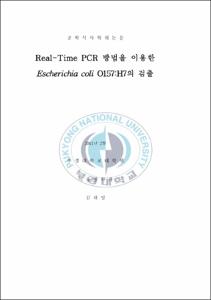Real-Time PCR 방법을 이용한 Escherichia coli O157:H7의 검출
- Alternative Title
- Detection of Escherichia coli O157:H7 using Real-Time PCR (Polymerase Chain Reaction) Assay
- Abstract
- Escherichia coli O157:H7, a foodborne pathogen, has been reported to cause many outbreaks in the world wide. Most outbreaks have been related with food consumption and the consumption of raw and under cooked ground beef has been specially involved. Apart from the traditional culture methods, which is time consuming and laborious process, relying on biochemical characteristics, molecular methods have been developed for rapid detection of E. coli O157:H7 in food. Molecular methods such as PCR are of interest for obtaining information on virulence factors. However, conventional PCR methods have several disadvantage such as poor precision, low sensitivity, non-automated and post-PCR processing for data analysis. Also, the PCR methods base on the amplification of a target gene has a problem to apply for the detection of pathogenic bacteria since the PCR reaction amplify all genetic materials from both dead and live cells. During food processing such as heat treatment, the genetic materials, specially DNA of bacteria will be remain in food even though the cells will be destroyed.
Recently, a real-time PCR assay has been applied to detect food pathogenic bacteria in various food. The assay has been concerned about time and labor saving to detect the pathogenic bacteria in food compared to the traditional cultivation methods using morphological and biochemical assay and conventional PCR methods.
The object of this study is to develop a real-time PCR method to differentiate between viable cells and dead cells and to apply the method for detecting E. coli O157:H7 in food samples. For the purpose, it was developed a new method to detect food pathogenic bacteria based on the combination of the real-time PCR and enriched cultivation supplemented with antibiotics.
The primers and probes designed for detecting E. coli O157:H7 using real-time PCR methods were specific only to E. coli O157:H7 not non-pathogenic E. coli and other bacteria. The Ct (Cycle threshold) values in real-time PCR were to be a does dependent on E. coli O157:H7 inocula. It was also observed the difference of Ct values between mEC enrichment cultures of E. coli O157:H7 in the presence or absence of gentamicin and tetracycline since E. coli O157:H7 cells were not grown in the presence of both antibiotics. These results suggested that it was possible to differentiate viable or dead cells of E. coli O157:H7 using the real-time PCR methods combined with enrichment culture supplemented with antibiotics. In conclusion, it was developed new method to detect only viable E. coli O157:H7 using the real-time PCR methods and the same strategy would apply to detect other pathogenic bacteria.
- Issued Date
- 2011
- Awarded Date
- 2011. 2
- Type
- Dissertation
- Publisher
- 부경대학교
- Alternative Author(s)
- Kim, Tae Young
- Affiliation
- 부경대학교 일반대학원
- Department
- 대학원 식품공학과
- Advisor
- 김영목
- Table Of Contents
- 서 론 1
재료 및 방법 5
1. 실험에 사용된 균주와 배지 5
2. DNA 추출 Kit 8
3. EC(O157:H7) quantitative PCR kit 8
4. Real-time PCR 장치 10
5. E. coli O157:H7 증균 배양법 11
6. DNA 추출 방법 11
7. agarose gel 전기영동법 12
8. E. coli O157:H7 real-time PCR법 12
결과 및 고찰 15
1. E. coli O157:H7 특이적 primers와 probes 제작 15
2. 증균 배지에서 real-time PCR을 이용한 E. coli O157:H7의 검출 23
2.1. 일반 증균 배지에서 real-time PCR을 이용한 E. coli O157:H7의 검출 23
2.2. EC(O157:H7) quantitative PCR Kit의 특이성 검증 25
2.3. 선택 증균 배지에서 real-time PCR을 이용한 E. coli O157:H7의 검출 30
3. E. coli O157:H7균 검출을 위한 방법으로 real-time PCR 적용의 문제점 35
4. Real-time PCR 및 선택적 증균 배양법을 이용한 E. coli O157:H7 검출 40
5. 선택적 증균 배양과 병행한 real-time PCR을 이용한 E. coli O157:H7 검출법의 식품시료에의 적용 46
요 약 54
감사의 글 57
참고 문헌 59
- Degree
- Master
- Files in This Item:
-
-
Download
 Real-Time PCR 방법을 이용한 Escherichia coli O157:H7의 검출.pdf
기타 데이터 / 1.04 MB / Adobe PDF
Real-Time PCR 방법을 이용한 Escherichia coli O157:H7의 검출.pdf
기타 데이터 / 1.04 MB / Adobe PDF
-
Items in Repository are protected by copyright, with all rights reserved, unless otherwise indicated.